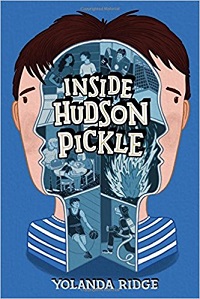| ________________
CM . . . . Volume XXIV Number . . . . November 10, 2017
excerpt:
At the beginning of grade seven in junior high, Hudson Pickle has a lot on his mind. His best friend Trevor has been giving him the cold shoulder for months because Hudson put hockey – his favourite sport – ahead of their friendship. Then Hudson was cut from his AAA hockey team because his speed and stick handling deteriorated as a result of a growth spurt. So now he’s feeling lonely, but he plans to try out for the school basketball team which he worries he won’t make. Plus, Hudson’s trying to figure out what’s up with Uncle Vic who’s recently moved in with him and his mother after his own apartment burned in a fire the authorities deem ‘suspicious’. Uncle Vic acts a little strange, and Hudson wonders if he’s using or dealing illicit drugs. And there’s school: it’s harder than it was in elementary, and Hudson has to do a big project on becoming a firefighter for Career & Tech. There’s also Willow, a girl Hudson likes, as well as Aidan, the bully who calls Hudson “wheezy” and who flirts with Willow. Less than a quarter of the way into the novel, it turns out that Uncle Vic has a genetic disease that affects the lungs and the liver. Hudson has asthma, but Uncle Vic wonders if he’s inherited the same disease. Uncle Vic knew Hudson’s father – someone his mother never talks about – and Hudson wants to know more about his father now, too. Some of his worst fears are confirmed after a Google search reveals that his father was a homeless drug addict. Uncle Vic eventually admits that he has become addicted to his prescription drugs and that he “exceed[s] the maximum dosage … regularly.” Inside Hudson Pickle has a number of valuable, if not subtle, messages for young people: don’t smoke; don’t do street drugs; don’t take more prescription pills than the doctor recommends; and “Addiction is an illness, not a choice. And like so many diseases, it can be genetic.” Mom, Trev, and Uncle Vic are credible characters. Uncle Vic, a rocker and hippy-style activist, is the character with most of the teachable problems, from his either genetic or second-hand smoke-induced cough, to his fatigue, to his drug use. Neither Hudson, Aiden, nor Willow are fully developed. Hudson’s character is often disconcertingly inconsistent. For instance, he’s portrayed as a classroom daydreamer whose thoughts are scattered. Yet, when he meets with Dr. M, who asks him if he knows what an ‘autosomal recessive disease’ means, he immediately answers, “We learned about it in science. It means you get one gene from your dad and one gene from your mom, right?” Aiden is a stereotypical bully, and the reader has no clue why he’s trying to bully Hudson. The bullying stops when they end up on the same basketball team. Aidan says, “I guess it’s time to call a truce,” and gives Hudson a ‘thumbs-up handshake.’ Willow fluctuates between being thoughtful and obtuse. Inside Hudson Pickle, a fast-paced story, works well for the first half of the book, but it falters as Hudson’s character loses credibility and the narrative begins to feel predominantly agenda driven. Recommended. Karen Rankin is a Toronto, ON, teacher and writer of children’s stories.
Next Review |
Table of Contents for This Issue
- November 10, 2017. |
